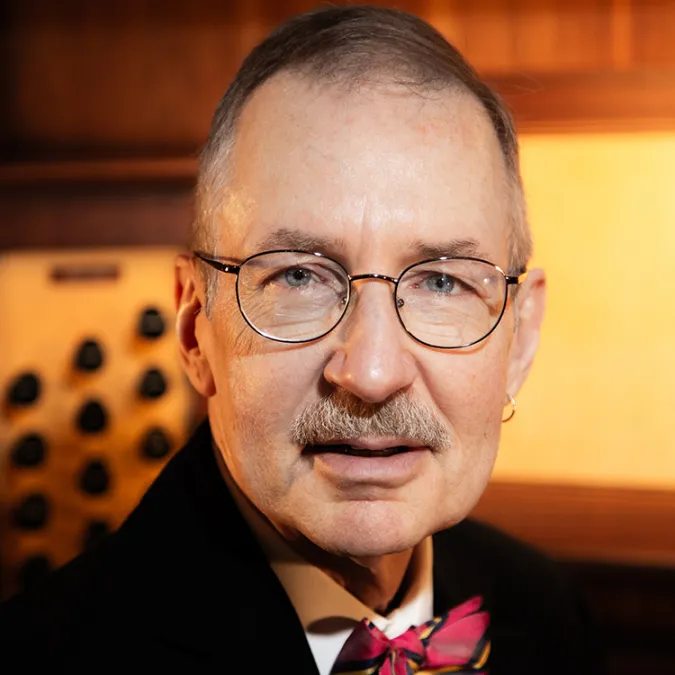
This concert will last about one hour without intermission.
Please silence your electronic devices.
Photography, video, or recording of any part of this performance is prohibited
Program
Emma Lou Diemer
Prepare the Royal Highway
Jan Zwart
Sombere Muziek
J.S. Bach
Prelude & Fugue in D, BWV 532
Percy Whitlock
Pazienza from Three Quiet Pieces
Felix Mendelssohn
Sonata in C Minor/Major, Op. 65, No. 2
Grave – Adagio
Allegro maestoso e vivace
Fuga: Allegro moderato
Scott Joplin
Wall Street Rag
Brenda Portman
Scherzo Texas premiere
Edward Elgar
Pomp and Circumstance
Military March in G, Op. 39, No.4
About the Program
Program notes by Gregory Eaton
In a recent interview, LL Cool J said that it was his job to go into a room and “paint on silence.” This is a wonderful way to express the way that music can be thought of as colors of sound. It was Wolfgang Amadeus Mozart who memorably called the organ, “the King of Instruments.” One of the features which sets the organ apart from any other instrument is the variety of sounds which are available, with a truly kaleidoscopic choice of timbres, pitches, and combinations of stops of varying character. At the discretion of the organist, there is the potential for everything ranging from the softest whisper to a mighty roar. The magnificent Bates Hall concert organ by Visser-Rowland Associates of Houston (1983) contains 5,315 pipes, ranging in length from 1/4" to 32' in speaking length, giving it a wider range of sounds than many smaller instruments. It is the goal of this concert to show off this variety.
Emma Lou Diemer
Prepare the Royal Highway
Born 1927
Died 2024
Composed 2001
Premiered 2002
Duration 5 minutes
Featured sounds: The bright sounds of reeds and mixtures, melody played in the pedals, and the ability of the organ to ‘terrace’ dynamics on different keyboards. Commissioned for the Philadelphia Convention of the American Guild of Organists in 2002, Prepare the Royal Highway is based upon a Swedish folk tune. For Americans, this tune is most familiar for use with an Advent hymn. A bold introduction leads into rocking chords over the first statement of the theme, presented in staccato notes in the pedals. As the piece proceeds, patterns and complex chords either accompany or proclaim the theme. Composer Emma Lou Diemer was highly regarded in her lifetime, composing for organ, choirs, orchestra, and other ensembles. A native of Missouri and longtime resident of California, she was composing right up until her death this year at the age of 96.
Jan Zwart
Sombere Muziek
Born 1877
Died 1937
Composed 1920
Premiered 1920
Duration 9 minutes
Featured sounds: The ability of the organ to begin on the softest possible stop, building to a full roar, and coming back down to pianissimo. This work of a Dutch composer is a fitting tribute to the Dutch ancestry and flavor of the Visser-Rowland organ in Bates Hall. The Solemn Music of Jan Zwart is part of a repertoire mostly unfamiliar to Americans, but deeply revered by many in the Netherlands. I have seen older Netherlanders especially moved whenever I have performed music of these composers. This Choraal-Klang tradition features pieces based on Dutch psalm tunes, but in highly emotionally-charged writing. This particular piece is written so that the organist regularly has a hand free in order to pull stops to build, and then retire stops to diminish, the sound of the organ. It ends with a very quiet statement of the psalm tune, in which different colors of sound will be used in each phrase for the solo melody.
J.S. Bach
Prelude & Fugue in D, BWV 532
Born 1685
Died 1750
Composed c1710
Duration 11 minutes
Featured sounds: The organ as a concerto grosso ensemble with one player. The Prelude and Fugue in D dates from Bach’s tenure as court musician in Weimar. There, he was able to write non-sacred music, and most all of the large organ works date from this time. It is easy to imagine a young Sebastian Bach having a great deal of fun with this piece. For the Prelude, a bravura opening includes a bit of stilus fantasticus. It begins with ascending scales in the pedal, and concludes with an even faster 2-octave scale in the keyboard. This is followed by an Alla breve section which seems firmly rooted in Italian concerto grosso style, providing the opportunity for a dialogue between different groups of stops. We know that Bach studied the music of the Italians extensively as a young man, and that is clearly audible here. The prelude ends, however with a very dramatic and Germanic return to stilus fantasticus, in counterpoint which utilizes double pedal. The fugue is very unlike the rest of the ‘Great’ fugues of this period. It is uniquely playful, and lends itself well to a concerto-style interpretation. The sounds chosen for this performance are meant to be humorous. After a youthful yet masterly exploration of counterpoint, the fugue ends with a decisive pedal octave, as if saying, ‘So there!’
Percy Whitlock
Pazienza
Born 1903
Died 1946
Composed 1943
Duration 4 minutes
Featured sounds: The string and flute stops of the organ. Organs often posses a stop labeled, ‘Celeste,’ which is tuned just slightly sharp of a paired stop. Together, these form a wonderful shimmering effect, which is heard in this piece. Last of a set called Reflections: Three Quiet Pieces for Organ, it is remarkable that a piece entitled ‘Patience’ was written by a composer losing his sight and close to dying of tuberculosis, at one of the worst periods of World War II. Post-romantic composer Percy Whitlock was a graduate of the Royal College of Music, and served several churches at the beginning of his career. However, the bulk of his work was in the secular field, as Borough Organist in Bournemouth, and as organist of the Pavilion Theatre in that city.
Felix Mendelssohn-Bartholdy
Sonata in C Minor/Major, Op. 65, No. 2
Born 1809
Died 1947
Composed 1844/45
Premiered 1845
Duration 10 minutes
Featured sounds: Solo reed stop accompanied by a flute; bright reed ensemble; crescendo from mezzo forte (loud) to fortissimo (very loud). Felix Mendelssohn-Bartholdy is credited for having ‘resurrected’ the organ music of J.S. Bach from its obscurity. His playing and composing changed organ culture in Germany, and especially in England, where he was highly admired. The Six Sonatas for Organ were commissioned in 1844 by the English publishing house of Coventry and Hollier. Their use of obbligato pedal meant that British organ building had to change; prior to this time, most British organs were not provided with a pedal division. The first movement begins with a stately declamation on the foundation stops of the organ. This is followed by a beautiful melody played on a solo stop (here, the Musette on the Zwellwerk), and accompanied by flute stops in the left hand and pedal. For the short but celebratory second movement, any loud combination may be used. Here, it is a group of stops known in French as the Grands Jeux, featuring bright reeds. Immediately after this, the Fugue begins. In this performance, you will hear a gradual crescendo from mezzo forte to fortissimo, accomplished in a different way from that in the Zwart.
Scott Joplin
Wall Street Rag
Born 1868
Died 1917
Composed 1909
Duration 5 minutes
Featured: Storytelling through composition and timbre. Though born and educated in Texarkana, TX, Scott Joplin became most famous as the ‘King of Ragtime’ in Sedalia, MO, where he wrote Maple Leaf Rag and many others which would achieve nationwide popularity. In hearing his compositions, one might reasonably believe that there is an attempt to tell a story through music. In Wall Street Rag, Joplin showed that this was exactly his intention, including descriptions of each section in the published score. This piece was written after his move to New York City, where he tried in vain to get his opera Treemonisha performed. It may be because he was in a mindset of operatic storytelling that Wall Street Rag has such a clear story intention. In designing the organ performance, care has been taken to make sure that the timbres used help to illuminate the story. Below are the section descriptions, exactly as written by the composer:
- Panic in Wall Street, Brokers feeling melancholy.
- Good times coming.
- Good times have come.
- Listening to the sounds of genuine negro ragtime, brokers forget their cares.
Brenda Portman
Scherzo
Born 1980
Composed 2023
Premiered June 2024
Duration 4 minutes
Featured: A lighthearted dialogue between various types of flue stops: flute, principal, and hybrid (the Quintadeen in the Rugwerk). This delightful Scherzo was commissioned for the semifinal round of the National Competition in Organ Improvisation at the 2024 convention of the American Guild of Organists. It received its premiere on June 28, 2024, being played by all five competitors in that round. Composer Brenda Portman has a dual career as a concert organist and composer. She writes for organ, choirs, voice, and instrumental ensembles, receiving many commissions. ‘Scherzo’ is Italian for ‘joke,’ and the lighthearted writing, featuring shifting meters and rhythms, expresses that very well. Tonight’s performance marks the first time this piece is heard in Texas.
Edward Elgar
Pomp & Circumstance Military March in G, Op. 39, No. 4
Born 1857
Died 1934
Composed 1907
Premiered 1907
Duration 5 minutes
Featured: the organ as a wind band. For centuries, compositions have been transcribed from their original instrumental ensemble form to be able to be played on the organ. Bach did this with concertos by Vivaldi and others, and with his own instrumental works. In the 19th and early 20th centuries, this practice became widespread to solve a widespread problem: Small cities and towns could not afford instrumental ensembles of their own, and therefore it was easier to put in a municipal organ and pay one person to perform the popular ensemble music of the day. When Edward Elgar wrote his Pomp and Circumstance Military Marches, they achieved worldwide popularity, leading to their transcription for organ. Though we have one of the best wind ensembles in the world here at The Butler School, it is a different experience to hear this piece in its solo organ form. It is my hope that you will find the effect on the organ as stirring as the full band.
About the Artist
Gregory Eaton

Gregory Eaton is lecturer in organ and harpsichord of the Butler School of Music, The University of Texas at Austin, and organist/choirmaster of All Saints’ Episcopal Church, in Austin. He also serves as secretary of the board for La Follia Austin Baroque Orchestra. From 2016 to 2024, he was president of the board for Ensemble VIII. Prior to moving to Texas, he was director of music at St. Ann & the Holy Trinity, Brooklyn, from 1993 to 2014, and lecturer in church music at the General Theological Seminary from 1984 to 2010. He also served at both Trinity Church and Church of the Epiphany in New York. While at St. Ann’s, Gregory founded a weekly recital series, on which he played over 600 concerts between 1999 and 2014. He was also a founding member of Chelsea Winds recorder ensemble, and plays in the Austin Recorder Quartet. Gregory has been very involved in the American Guild of Organists, having served as dean of both the Booklyn and Austin chapters, and as district convener for Central Texas.
Upcoming Events

Wind Ensemble
20th Anniversary Performance of Circus Maximus
by John Corigliano
Join us this winter in Downtown Austin for the 20th Anniversary Performance of John Corigliano's epic third symphony, Circus Maximus. Commissioned by The University of Texas Wind Ensemble and premiered in 2004, Circus Maximus is scored for three different bands: one on stage, an antiphonal ensemble in the hall, and a marching band. The composer used the Circus Maximus arena in Rome as inspiration, with the audience situated in the center, surrounded by sound. Get your tickets now!
Saturday, January 25, 7:30 p.m.
The Long Center for the Performing Arts
Triptych Trio
Wednesday, October 23, 7:30 p.m.
Bates Recital Hall
Symphony Orchestra
Featuring Jonathan Gunn, clarinet
Saturday, October 26, 7:30 p.m.
Bates Recital Hall
Miró Quartet
Monday, October 28, 7:30 p.m.
Bates Recital Hall
Yamazalde Trio
Thursday, October 31, 7:30 p.m.
Bates Recital Hall
John Largess, viola & Tamar Sanikidze, piano
Thursday, November 7, 7:30 p.m.
Bates Recital Hall
Event Details
$10–20
All University of Texas at Austin students are allowed one free ticket as long as they are available. Student tickets must be picked up at the Box Office with valid student I.D. Seating is unassigned.
If you are a patron with ADA needs, please email tickets@mail.music.utexas.edu and we will reserve ADA seating for you.

